Progress and Challenges Connected with the Integration of Renewable Energy Sources with Railway Distribution Networks
Abstract
1. Introduction
2. Use of Renewable Energy Sources
2.1. Traction Consumers
2.2. Non-Traction Consumers
- Conversion system between 3000 Vdc and 400 Vac. The conversion system can be realized with two different modules: the first one is made up of a step-down chopper that converts and stabilizes the 3000 Vdc voltage to 650 ÷ 800 Vdc and the second one is made up of an inverter that converts the dc voltage from the output of the chopper to 400 Vac voltage to supply the station loads.
- Station electrical load. Evaluation of network configuration, contracted capacity, generation profile and capacity.
- PV shelters. Optimal inclination and exposition of PV modules.
- Distribution company. A connection to the distribution network can be present in order to allow the bi-directional energy exchange with the railway station power plant; this can be present and used only in emergency conditions to supply the railway station loads or absent.
2.3. Railway along the Railway Track
- Existing and newly electrified railway lines will be powered with RES energy;
- Creation of a zero-emission access infrastructure to the CPK airport, as part of the CPK Rail Programme being implemented;
- Implementation of investments in line with the Rail Plus Act, mainly the restoration of disused lines and the prevention of rail infrastructure decommissioning, in a way that does not increase CO2 emissions;
- Making rail passenger transport more attractive by introducing the “green ticket” concept for passengers.
3. Criteria for the Connection of Generation Sources to the Distribution Network
4. Grid Problems Caused by RES and Possible Solutions
5. Discussion
| Connection Point/Functionality | 110 kV (HV) of DC Traction | MV (15) Supply Side of DC Traction | MV Non-Traction Load of 110/15 Transformer in DC Traction | AC Traction | DC Side (1 Way Power Flow) + Energy Storage | Train + Energy Storage in DC |
|---|---|---|---|---|---|---|
| Typical active power capacity | <100 MW | <10 MW | ~1 MW | A few MW | A few MW | A few -tens kW |
| Compensation of load inductive power | Possibility to reduce losses in 110 kV lines | Possibility to reduce losses in MV lines (losses are higher than in 110 kV) | Limited possibilities to reduce reactive power flowing through 110 kV lines | Large potential | Reduction of reactive power losses by reduction of load active power | No |
| Reduction of active energy supplied from the networ | Yes, effectivness depend on load and generation profiles | |||||
| Recuperation capabilities of energy storage | Only if 2 way inverter is uesd for traction supply | Only if 2 way inverter is uesd for traction supply | Only if 2 way inverter is uesd for traction supply; limited power | Yes | Full capabilites irrespective on inverter | No |
| Stabilization of voltage in traction network | Limited potential | Big potential | Limited potential | Large potential | The largest potential | Minimal, by reduction of train peak power |
| Reduction of traction transformer peak power | Minimal by optimization of voltage level and reduction of current for same power; large potential if renewables are connected to secondary windings of AC transformer in case of AC traction | Large potential | ||||
| Reduction of losses | Significant | Larger potential than in HV lines, particularly in case of long supply lines | Noticeable | |||
| Compensation of capacitive no load power from distribution system | Yes | No | ||||
| Grid support | Virtual inertia, synchrocheck support [83,84] | Limited | ||||
6. Conclusions
Author Contributions
Funding
Data Availability Statement
Conflicts of Interest
References
- Bostan, I.; Gheorghe, A.; Dolgheru, V.; Sobor, I.; Bostan, V.; Sochirean, A. Resilient Energy Systems. Renewables: Wind, Solar, Hydro; Springer: Berlin, Germany, 2013. [Google Scholar] [CrossRef]
- Marks-Bielska, R.; Bielski, S.; Pik, K.; Kurowska, K. The Importance of Renewable Energy Sources in Poland’s Energy Mix. Energies 2020, 13, 4624. [Google Scholar] [CrossRef]
- Oyekale, J.; Petrollese, M.; Tola, V.; Cau, G. Impacts of Renewable Energy Resources on Effectiveness of Grid-Integrated Systems: Succinct Review of Current Challenges and Potential Solution Strategies. Energies 2020, 13, 4856. [Google Scholar] [CrossRef]
- Möst, D.; Misconel, S.; Herbst, A.; Jakob, M.; Martino, A.; Poganietz, W.P. The Future European Energy System Renewable Energy, Flexibility Options and Technological Progress: Renewable Energy, Flexibility Options and Technological Progress; Springer: New York, NY, USA, 2021. [Google Scholar] [CrossRef]
- Fetting, C. The European Green Deal, ESDN Report; ESDN Office: Vienna, Austria, 2020. [Google Scholar]
- Kougias, I.; Taylor, N.; Kakoulaki, G.; Jäger-Waldau, A. The role of photovoltaics for the European Green Deal and the recovery plan. Renew. Sustain. Energy Rev. 2021, 144, 111017. [Google Scholar] [CrossRef]
- Szpilko, D.; Ejdys, J. European Green Deal–research directions. A systematic literature review. Econ. Environ. 2022, 81, 8–38. [Google Scholar] [CrossRef]
- Implementation of the European Green Deal. Available online: https://commission.europa.eu/strategy-and-policy/priorities-2019-2024/european-green-deal/delivering-european-green-deal_pl (accessed on 4 August 2023).
- Strategic Energy Technology Plan. Available online: https://energy.ec.europa.eu/topics/research-and-technology/strategic-energy-technology-plan_en (accessed on 4 August 2023).
- Accelerate the Development of RES. Available online: https://powermeetings.eu/wp-content/uploads/2023/02/Przyspieszyc%CC%81-rozwo%CC%81j-OZE.pdf (accessed on 4 August 2023).
- Ouaid, M.; Ouassaid, M.; Tebaa, M. Gain Assessment of Powering Train Loads with Rooftop Solar Panels: Case study of Morocco. In Proceedings of the 5th Global Power, Energy and Communication Conference, Nevsehir, Turkey, 15–16 June 2023. [Google Scholar] [CrossRef]
- George, N.; Chowdhury, S.D. Roof-Top Solar Power Augmentation to Auxiliary Supply of Passenger Train. In Proceedings of the 2018 IEEE PES/IAS PowerAfrica, Cape Town, South Africa, 28–29 June 2018. [Google Scholar] [CrossRef]
- Lencwe, M.J.; Chowdhury, S.P.; ElGohary, H.M. Solar photovoltaic integration on locomotive roof top for South African railway industry. In Proceedings of the 2016 51st International Universities Power Engineering Conference (UPEC), Coimbra, Portugal, 6–9 September 2016. [Google Scholar] [CrossRef]
- Shravanth Vasisht, M.; Vashista, G.A.; Srinivasan, J.; Ramasesha, S.K. Rail coaches with rooftop solar photovoltaic systems: A feasibility study. Energy 2017, 118, 684–691. [Google Scholar] [CrossRef]
- Hyman, M.; Ali, M.H. A Novel Model for Wind Turbines on Trains. Energies 2022, 15, 7629. [Google Scholar] [CrossRef]
- Zulu, J.; Lencwe, M.J.; Chowdhury, S.P.D. Green Energy for railway train mounted Wind Generator. In Proceedings of the 2019 10th International Renewable Energy Congress (IREC), Sousse, Tunisia, 26–28 March 2019. [Google Scholar] [CrossRef]
- Mishra, A.; Ashhad, F.; Shukla, V. A Concept for Wind power Generated in High Speed Luxury Trains. Int. J. Appl. Eng. Res. 2019, 14, 38–42. [Google Scholar]
- Abbas, M.A.; Anwar, M.; Rana, M.R. Electricity Generation by Fast Moving Vehicles using Wind Turbine (Metro Rail). In Proceedings of the 2021 1st International Conference on Power Electronics and Energy (ICPEE), Bhubaneswar, India, 2–3 January 2021. [Google Scholar] [CrossRef]
- Nurmanova, V.; Bagheri, M.; Phung, T.; Panda, S.K. Feasibility study on wind energy harvesting system implementation in moving trains. Electr. Eng. 2017, 100, 1837–1845. [Google Scholar] [CrossRef]
- Sahu, J.K.; Sahu, M. Micro Wind Turbine Technology: To Enhance Self Generative System in Passenger Train. Int. Res. J. Eng. Technol. IRJET 2016, 3, 629–634. [Google Scholar]
- Sun, Y.; Anwar, M.; Hassan, N.M.S.; Spiryagin, M.; Cole, C. A review of hydrogen technologies and engineering solutions for railway vehicle design and operations. Railw. Eng. Sci. 2021, 29, 212–232. [Google Scholar] [CrossRef]
- Haseli, Y.; Naterer, G.F.; Dincer, I. Comparative assessment of greenhouse gas mitigation of hydrogen passenger trains. Int. J. Hydrogen Energy 2008, 33, 1788–1796. [Google Scholar] [CrossRef]
- Sabillon, C.; Birendra, N.; Singh, N.; Venkatesh, B. Technoeconomic Models for the Optimal Inclusion of Hydrogen Trains in Electricity Markets. IEEE Trans. Transp. Electrif. 2019, 5, 758–768. [Google Scholar] [CrossRef]
- Washing, E.M.; Pulugurtha, S.S. Energy demand and emission production comparison of electric, hydrogen and hydrogen-hybrid light rail trains. Int. J. Rail Transp. 2016, 4, 55–70. [Google Scholar] [CrossRef]
- D’Ovidio, G.; Ometto, A.; Valentini, O. A novel predictive power flow control strategy for hydrogen city rail train. Int. J. Hydrogen Energy 2020, 45, 4922–4931. [Google Scholar] [CrossRef]
- Rechard, G.; Gouttefangeas, R. Recovering energy from train braking for traction and grid use. In Proceedings of the World Engineers Summit—Applied Energy Symposium & Forum: Low Carbon Cities & Urban Energy Joint Conference, WES-CUE 2017, Singapore, 19–21 July 2017. [Google Scholar] [CrossRef]
- Wu, X.; Qi, L.; Zhang, T.; Zhang, Z.; Yuan, Y.; Liu, Y. A novel kinetic energy harvester using vibration rectification mechanism for self-powered applications in railway. Energy Convers. Manag. 2021, 228, 113720. [Google Scholar] [CrossRef]
- Hadas, Z.; Rubes, O.; Ksica, F.; Chalupa, J. Kinetic Electromagnetic Energy Harvester for Railway Applications—Development and Test with Wireless Sensor. Sensors 2022, 22, 905. [Google Scholar] [CrossRef]
- Graff, M. Pojazdy Coradia iLint z ogniwami paliwowymi na wodór. TTS Tech. Transp. Szyn. 2018, 25, 36–37. [Google Scholar]
- Indian Railways Launches First Solar-Powered DEMU Train. Available online: https://indianexpress.com/article/india/indian-railways-launches-first-solar-powered-demu-train-4750664 (accessed on 21 February 2023).
- Byron Bay Train. Available online: https://byronbaytrain.com.au/sustainability (accessed on 28 February 2023).
- Rays and Rails—A Match Made in Heaven? Available online: https://cosmosmagazine.com/science/engineering/solar-powered-trains/ (accessed on 7 August 2023).
- Alstom Coradia iLint. Available online: https://www.alstom.com/solutions/rolling-stock/alstom-coradia-ilint-worlds-1st-hydrogen-powered-passenger-train#:~:text=The%20Coradia%20iLint%20is%20the,only%20steam%20and%20condensed%20water (accessed on 7 August 2023).
- Over Half of EU Locomotives Still Run on Diesel: The Road to Net Zero. Available online: https://www.railtech.com/rolling-stock/2023/05/09/over-50-of-eu-locomotives-still-run-on-diesel-the-road-to-net-zero/?gdpr=accept (accessed on 7 August 2023).
- Railway Lines in Poland—Basic Parameters. Available online: https://utk.gov.pl/pl/aktualnosci/19158,Linie-kolejowe-w-Polsce-podstawowe-parametry.html (accessed on 7 August 2023).
- CRRC Hydrogen Locomotive. Available online: https://www.railway-technology.com/news/crrc-unveils-worlds-most-powerful-hydrogen-train/ (accessed on 7 August 2023).
- SM41-6Dn Hydrogen. Available online: https://pesa.pl/produkty/lokomotywy/sm42-6dn-hydrogen/#desc (accessed on 7 August 2023).
- Wind-Powered Trains in the Netherlands. Available online: https://www.gramwzielone.pl/energia-wiatrowa/24954/pociagi-w-holandii-zasilane-energia-z-wiatru (accessed on 8 August 2023).
- Official Website of OBB. Available online: https://infrastruktur.oebb.at/en/company/environment-climate-protection/green-electricity (accessed on 8 August 2023).
- Stadler Will Use Efficient ABB Solutions in FLIRT Trains for PKP Intercity. Available online: https://new.abb.com/news/pl/detail/59358/stadler-wykorzysta-wydajne-rozwiazania-abb-w-pociagach-flirt-dla-pkp-intercity (accessed on 8 August 2023).
- PKP Intercity Presents Rolling Stock Plans for 2023. Available online: https://bydgoszcz.naszemiasto.pl/pkp-intercity-prezentuje-plany-taborowe-na-2023-rok/ar/c3-9165143 (accessed on 8 August 2023).
- Official Website of DB. Available online: https://nachhaltigkeit.deutschebahn.com/en/measures/Brake-energy-recovery (accessed on 8 August 2023).
- Deutsche Bahn 2021 Integrated Report. Available online: https://ir.deutschebahn.com/fileadmin/Englisch/2021e/Berichte/DBK_e_IB21_web.pdf (accessed on 28 February 2023).
- UIC—Technologies and Potential Developments for Energy Efficiency and Co Reductions in Rail Systems. Available online: https://uic.org/IMG/pdf/_27_technologies_and_potential_developments_for_energy_efficiency_and_co2_reductions_in_rail_systems._uic_in_colaboration.pdf (accessed on 28 February 2023).
- Faranda, R.; Leva, S. Energetic sustainable development of railway stations. In Proceedings of the 2007 IEEE Power Engineering Society General Meeting, Tampa, FL, USA, 24–28 June 2007. [Google Scholar] [CrossRef]
- Barra Caracciolo, M.; Faranda, R.; Leva, S. Photovoltaic applications in railway stations. In Proceedings of the 19th International Conference on Electricity Distribution, Vienna, Austria, 21–24 May 2007. [Google Scholar]
- Vrignaud, G. Substation with zero auxiliary consumption. In Proceedings of the 9th World Congress on Railway Research, Lille, France, 22–26 May 2011. [Google Scholar]
- Memoria de Sostenibilidad 2019. Available online: https://www.fgv.es/wp-content/uploads/2021/02/Memoria-Sostenibilidad-FGV-2019-ES_Completa.pdf (accessed on 7 February 2023).
- FGV-Installation of Photovoltaic Solar Panels. Available online: https://www.fgv.es/corporate-social-responsibility/sostenibilidad/programa-de-actuacion-medioambiental/?lang=en (accessed on 8 August 2023).
- Green Indian Railways. Available online: https://indianrailways.gov.in/railwayboard/uploads/directorate/secretary_branches/IR_Reforms/Green%20Railways%20(use%20of%20renewable%20energy).pdf (accessed on 8 August 2023).
- 5 Ways the Indian Railways Is Adopting Renewable Energy to Reduce Its Carbon Footprint. Available online: https://www.thebetterindia.com/49266/indian-railways-renewable-energy/ (accessed on 16 February 2023).
- We Are Tapping into the Sun. Available online: https://nachhaltigkeit.deutschebahn.com/en/measures/solar-engergy (accessed on 28 February 2023).
- Deutsche Bahn Is Testing the Use of Solar Panels on Railway Sleepers. Available online: https://sundries.news/deutsche-bahn-is-testing-the-use-of-solar-panels-on-railway-sleepers/ (accessed on 15 November 2023).
- Greenrail, Turning Railways into Clean Energy Producers. Available online: https://bertrandpiccard.com/articles/greenrail-turning-railways-into-clean-energy-producers (accessed on 8 August 2023).
- Goncharov, Y.; Sychenko, V. Improvement of Traction Supply System Effectiveness with Application of Electrical Alternative Energy Sources. Probl. Kolejnictwa 2014, 162, 65–82. [Google Scholar]
- Green Substations. Available online: https://pgeenergetykakolejowa.pl/strona/zielone-podstacje (accessed on 8 August 2023).
- PKP Energetyka Has 360 “Green” Substations. Available online: https://www.rynekinfrastruktury.pl/wiadomosci/polityka-i-prawo/pkp-energetyka-ma-360-zielonych-podstacji-84785.html (accessed on 8 August 2023).
- Sablin, O.; Bosyi, D.; Kuznetsov, V.; Lewczuk, K.; Kebal, I.; Myamlin, S.S. Efficiency of energy storage control in the electric transport systems. Arch. Transp. 2022, 62, 105–122. [Google Scholar] [CrossRef]
- Ruziev, D. The Use of Solar Batteries at Power Supply of Turnout Electric Drives on the Example of Uzbekistan Railways. Transp. Autom. Res. 2022, 8, 48–66. [Google Scholar] [CrossRef]
- Białoń, A.; Kuznetsov, V.; Hubskyi, P.; Ostapchuk, O. Proposals for the use of renewable energy sources for traffic control devices power supply. In Proceedings of the Transport Means 2020—24th International Scientific Conference, Kaunas, Lithuania, 30 September–2 October 2020. [Google Scholar]
- PGE Energetyka Kolejowa, Dostepne Moce, Informacje o Stanie Przylaczen w Sieci. Available online: https://pgeenergetykakolejowa.pl/firma/3-9-dostepne-moce-informacje-o-stanie-przylaczen-do-sieci (accessed on 15 November 2023).
- The Second Edition of the European Investment Bank’s Climate Change Survey, Conducted in Cooperation with BVA. Available online: https://www.eib.org/en/surveys/climate-survey/all-resources.htm (accessed on 28 February 2023).
- Green Railway in Poland. Available online: https://ungc.org.pl/wp-content/uploads/2021/10/Raport_Zielona_kolej_w-Polsce.pdf (accessed on 8 August 2023).
- Kuznetsov, V.; Hubskyi, P.; Rojek, A. The methods to increase the use of renewable energy sources in railways. In Proceedings of the Transport Means 2023, 27th International Scientific Conference, Katowice, Poland, 15–19 October 2023; Part II. pp. 782–786. [Google Scholar] [CrossRef]
- PKP Energetyka S.A. Standard: Connection Criteria and Technical Requirements for Micro and Small Installations Connected to the Low Voltage Distribution Grid. Available online: https://pgeenergetykakolejowa.pl/files/companypages/2022/07/Kryteriaprzylaczaniaorazwymaganiatechnicznedlamikroinstalacjiimalychinstalacjiprzylaczanychdosieciniskiegonapiecia.pdf (accessed on 8 August 2023).
- PKP Energetyka S.A. Standard: Technical Criteria for Assessing the Possibility of Connecting Generation Units to the Medium-Voltage Distribution Network. Available online: https://pgeenergetykakolejowa.pl/files/companypages/2022/07/KryteriatechniczneocenymozliwosciprzylaczeniajednostekwytworczychdosiecidystrybucyjnejSN.pdf (accessed on 8 August 2023).
- Łowczowski, K.; Roman, J. Techno-Economic Analysis of Alternative PV Orientations in Poland by Rescaling Real PV Profiles. Energies 2023, 16, 6277. [Google Scholar] [CrossRef]
- Artyszak, D. Magazyn energii trakcyjnej PKP Energetyka S.A. Rezultaty projektu i dalsze możliwości rozwoju. Energetyka Rozproszona Zesz. 2022, 7, 63–75. [Google Scholar] [CrossRef]
- Kuznietsov, M.; Kuznetsov, V.; Ostapchuk, O.; Kuznetsov, V.; Hubskyi, P. Rational Integration Level of Solar Generation in Traction Power Supply Substations for Supplying Auxiliary Consumers. In Proceedings of the 25th International Scientific Conference. Transport Means 2021, Kaunas, Lithuania, 6–8 October 2021; Part III. pp. 1133–1139. [Google Scholar]
- Łowczowski, K.; Czerniak, M.; Zawodniak, J.J. Connection of PV Sources Into Transmission Grid vs. Thermal Overload Risk of Wires and Cables. Autom. Elektr. Zakłócenia 2021, 12, 48–56. [Google Scholar] [CrossRef]
- Udzik, M.; Łowczowski, K.; Zawodniak, J.J. Connection of photovoltaic sources to the low voltage distribution network vs. risk of overloading the transformer station. Part 1: Characteristics of the existing state. Przegląd Elektrotechniczny 2023, 99, 175–179. [Google Scholar] [CrossRef]
- Udzik, M.; Łowczowski, K.; Zawodniak, J.J. Connection of photovoltaic sources to the low voltage distribution network vs. risk of overloading the transformer station. Part 2: Simulation analysis. Przegląd Elektrotechniczny 2023, 99, 180–183. [Google Scholar] [CrossRef]
- Femine, A.D.; Gallo, D.; Giordano, D.; Landi, C.; Luiso, M.; Signorino, D. Power Quality Assessment in Railway Traction Supply Systems. IEEE Trans. Instrum. Meas. 2020, 69, 2355–2366. [Google Scholar] [CrossRef]
- Kaleybar, H.J.; Brenna, M.; Foiadelli, F.; Fazel, S.S.; Zaninelli, D. Power Quality Phenomena in Electric Railway Power Supply Systems: An Exhaustive Framework and Classification. Energies 2020, 13, 6662. [Google Scholar] [CrossRef]
- PKP Energetyka with a Hydrogen Tender. Available online: https://www.rynek-kolejowy.pl/mobile/pkp-energetyka-z-przetargiem-wodorowym-106533.html (accessed on 8 August 2023).
- Energy Storage. 2.5 Thousand Rides Powered in Two Months. Available online: https://www.rynekinfrastruktury.pl/wiadomosci/intermodal-i-logistyka/magazyn-energii-25-tysiaca-przejazdow-zasilonych-w-dwa-miesiace-78163.html (accessed on 8 August 2023).
- Sharifi, S.; Ferencz, I.F.; Kamel, T.; Petreuş, D.; Tricoli, P. Medium-voltage DC electric railway systems: A review on feeding arrangements and power converter topologies. IET Electr. Syst. Transp. 2022, 12, 223–237. [Google Scholar] [CrossRef]
- Arboleya, P.; Mayet, C.; Mohamed, B.; Aguado, J.A.; de la Torre, S. A review of railway feeding infrastructures: Mathematical models for planning and operation. eTransportation 2020, 5, 100063. [Google Scholar] [CrossRef]
- Ladniak, L. Transformacja napiec i pradow w ukladach zasilania trakcji kolei duzych predkosci. In Proceedings of the Transcomp—XIV International Conference Computer Systems Aided Science, Industry and Transport, Toulouse, France, 12–16 June 2023. [Google Scholar]
- Yun, C.-M.; Cho, G.-J.; Kim, H.; Jung, H. A Study on the Train Brake Position-Based Control Method for Regenerative Inverters. Energies 2022, 15, 6572. [Google Scholar] [CrossRef]
- Rojek, Wpływ obciążenia na charakterystykę filtru typu gamma. TTS Tech. Transp. Szyn. 2000, 7, 43–47. Available online: https://bibliotekanauki.pl/articles/250699 (accessed on 15 November 2023).
- Nilson, P. Overhead Lines vs. Third Rail: How Does Rail Electrification Work? Available online: https://www.railway-technology.com/features/overhead-lines-vs-third-rail-how-does-rail-electrification-work/ (accessed on 15 November 2023).
- Łowczowski, K.; Miller, P.; Udzik, M.; Złotecka, D. Switching Operations in 110 kV Networks in the Context of Synchro-Check and Mitigation of Switching Stress by Utilizing Proper Control of Renewables and Energy Storages. Energies 2023, 16, 6434. [Google Scholar] [CrossRef]
- Machowski, J.; Lubosny, Z.; Bialek, J.; Bumby, J.R. Power System Dynamics: Stability and Control; Wiley: Hoboken, NJ, USA, 2020. [Google Scholar]
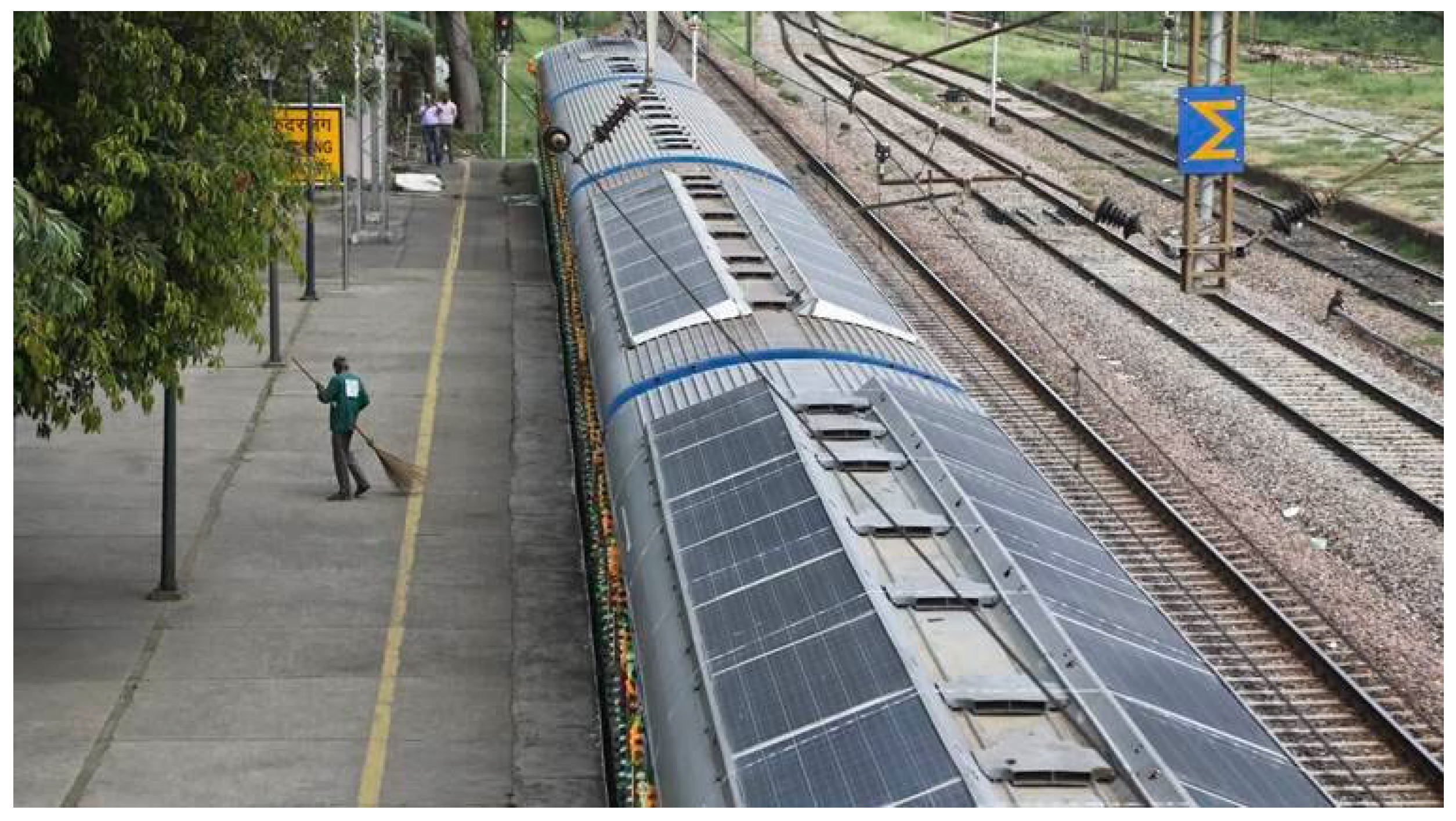
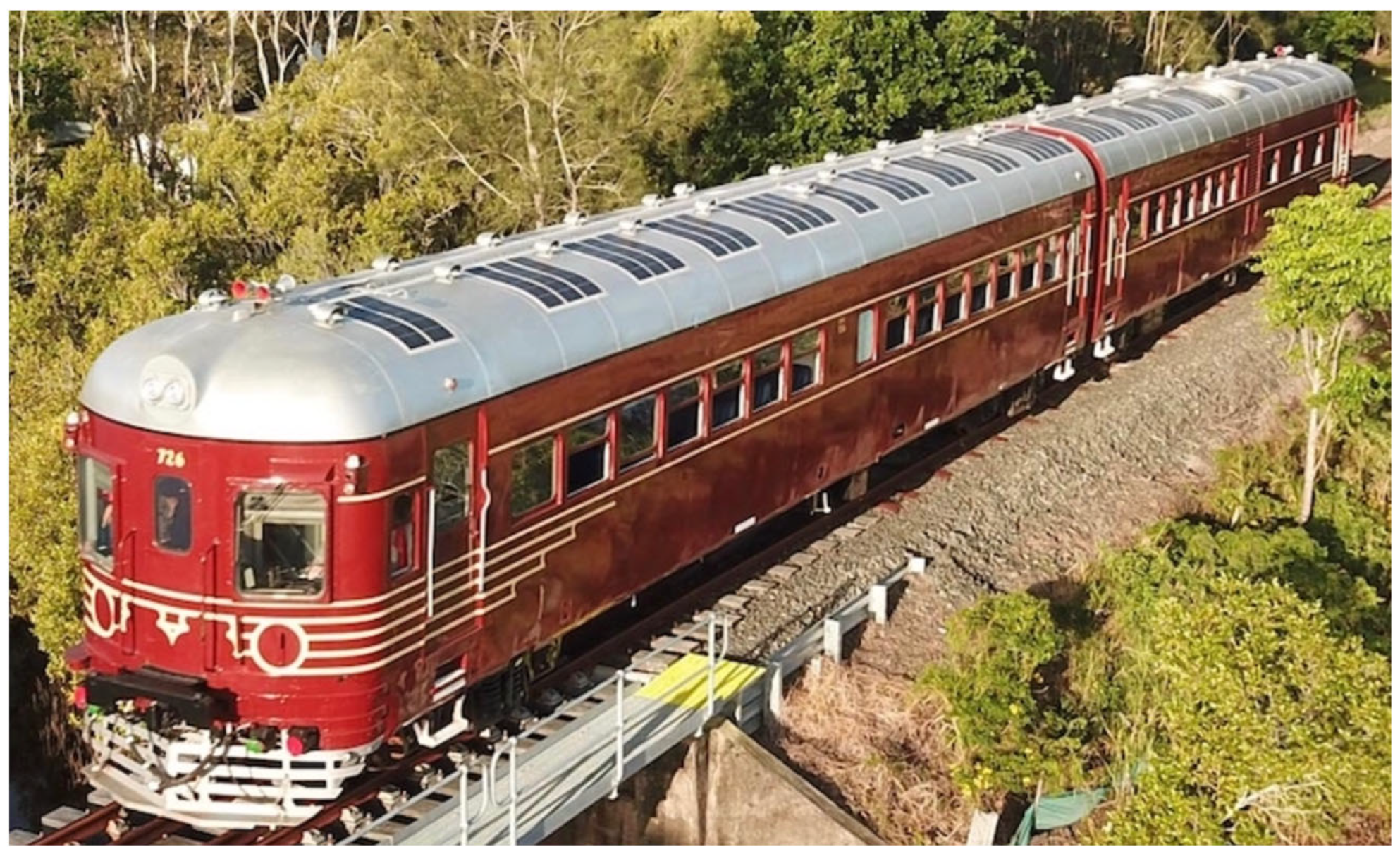

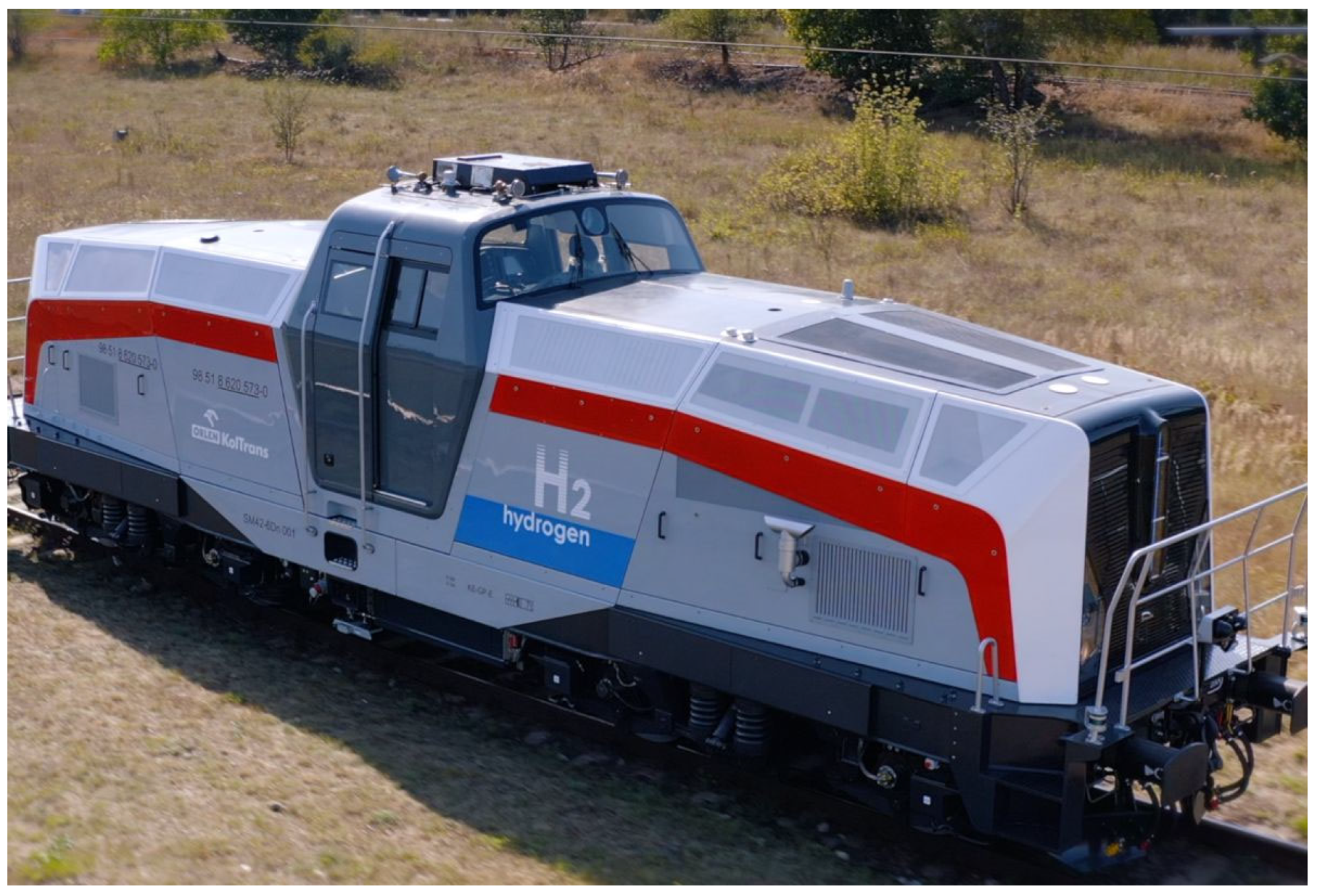

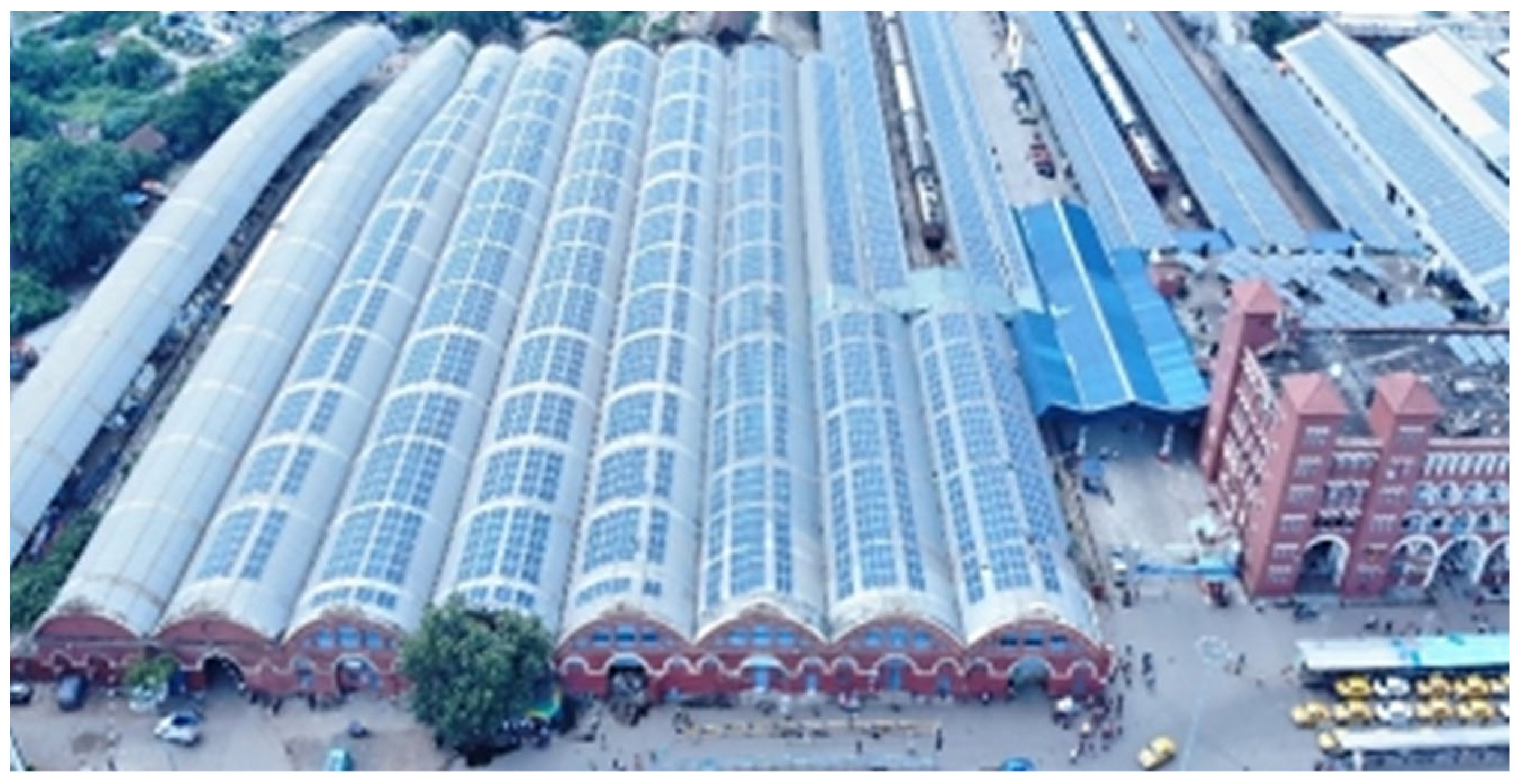
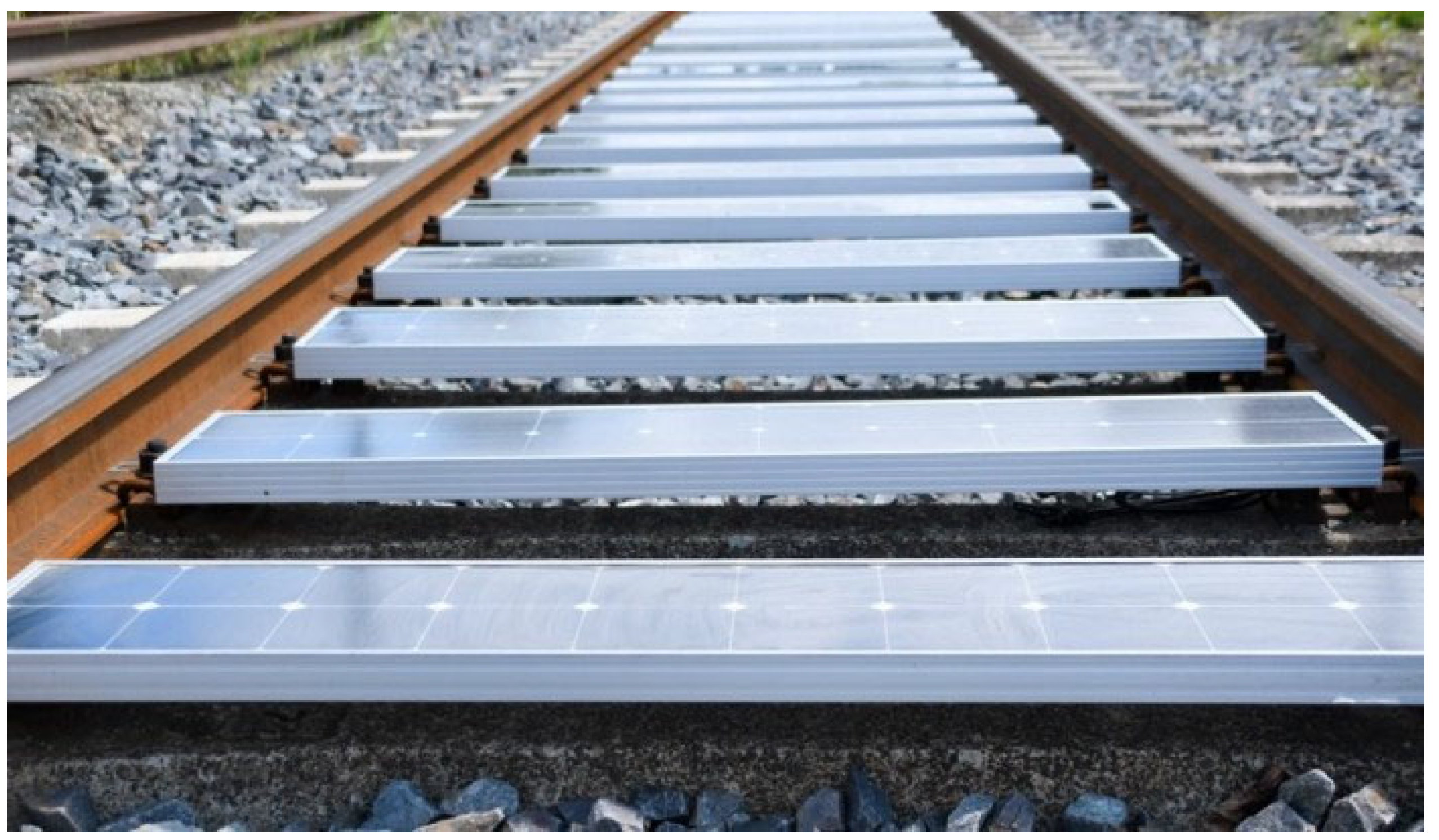

| Devices | Annual Energy Consumption (kWh) | Average Monthly Consumption [kWh] | Average Daily Consumption [kWh] | Average Hourly Consumption [kW] |
|---|---|---|---|---|
| Automatic block section | 5101 | 425.08 | 14.17 | 0.59 |
| Level crossing | 5425 | 452.08 | 15.07 | 0.63 |
| DSAT devices | 7789 | 649.08 | 21.64 | 0.90 |
| Number of Micro-Installations Connected to the Grid [-] | Installed Capacity of RES Micro-Installations [MW] |
|---|---|
| 650 | 11.83327 |
| Number of Small-Scale and Other RES Installations Connected to the Grid [-] | Installed Capacity of Small-Scale and Other RES Installations [MW] |
|---|---|
| 17 | 12.792 |
Disclaimer/Publisher’s Note: The statements, opinions and data contained in all publications are solely those of the individual author(s) and contributor(s) and not of MDPI and/or the editor(s). MDPI and/or the editor(s) disclaim responsibility for any injury to people or property resulting from any ideas, methods, instructions or products referred to in the content. |
© 2024 by the authors. Licensee MDPI, Basel, Switzerland. This article is an open access article distributed under the terms and conditions of the Creative Commons Attribution (CC BY) license (https://creativecommons.org/licenses/by/4.0/).
Share and Cite
Kuznetsov, V.; Hubskyi, P.; Rojek, A.; Udzik, M.; Lowczowski, K. Progress and Challenges Connected with the Integration of Renewable Energy Sources with Railway Distribution Networks. Energies 2024, 17, 489. https://doi.org/10.3390/en17020489
Kuznetsov V, Hubskyi P, Rojek A, Udzik M, Lowczowski K. Progress and Challenges Connected with the Integration of Renewable Energy Sources with Railway Distribution Networks. Energies. 2024; 17(2):489. https://doi.org/10.3390/en17020489
Chicago/Turabian StyleKuznetsov, Valeriy, Petro Hubskyi, Artur Rojek, Magdalena Udzik, and Krzysztof Lowczowski. 2024. "Progress and Challenges Connected with the Integration of Renewable Energy Sources with Railway Distribution Networks" Energies 17, no. 2: 489. https://doi.org/10.3390/en17020489
APA StyleKuznetsov, V., Hubskyi, P., Rojek, A., Udzik, M., & Lowczowski, K. (2024). Progress and Challenges Connected with the Integration of Renewable Energy Sources with Railway Distribution Networks. Energies, 17(2), 489. https://doi.org/10.3390/en17020489







